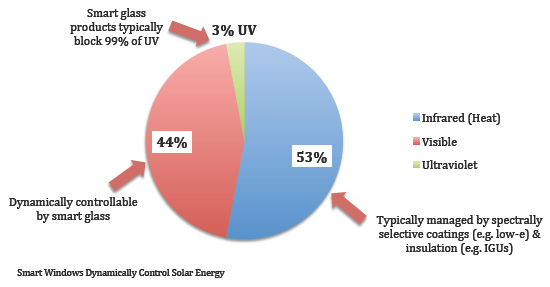Smart Glass Applications with Polymer Dispersed Liquid Crystal (PDLC) Technology
Privacy, Occupant Comfort, Energy Use Reduction with PDLC Technology
PDLC switchable glass is a solution for privacy, heat, and light management. When opaque, PDLC switchable glass provides full privacy. By the nature of the liquid crystal droplets, privacy is achieved while still allowing the vast majority of available light to enter the space, creating a private environment with the benefits of natural light. This contributes to environments that have open floor plans where natural light can penetrate deep into the space. Additionally, switching from opaque to clear in less than a second makes it an instant privacy solution.
PDLC switchable glass typically blocks 99% of UV rays, which cause damage and discoloration of interior walls, carpets, and furnishings.
In its opaque state, PDLC smart glass can reduce solar heat gain by up to 40%. The reduced heat gain in hot months helps keep the interior cooler, thus requiring less air conditioning producing increased occupant comfort, and providing cost savings.

Image courtesy of Glass Apps
Exterior Glazing Applications
While the past few decades have seen elevation of the idea of “smart buildings,” there can be no such thing unless the envelope itself is smart, ideally able to change properties as exterior light and temperature changes. Switchable glass offers that possibility. Here are some benefits:
Contributes to a modern environment — While certain architectural styles may lend themselves to heavy drapery and blinds, the modern aesthetic is a perfect match for switchable glass. Far from weakening contemporary interior styles, PDLC switchable glass adds value to them. Aside from aesthetics, PDLC switchable glass can be used in conjunction with automation systems, contributing to a connected/interactive home or office.
Improved air quality — PDLC switchable glass reduces the need for dust-collecting drapery, which can add greatly in the quest for superior air quality. It is not uncommon during summer and winter months to have air recirculating through a space. With the removal of bacteria and dust collecting materials such as drapery, much of the harmful dust and allergens are easily removed from the space.
Or, in homes or environments where drapery, blinds, or other window coverings are preferred, switchable glass provides another level of heat and UV protection and privacy.
Interior Applications
Creates flexible use of space — The example of a corporate board room mentioned earlier illustrates the ability for a space to be open at times and private at times, as needs dictate. Because we, as humans, are programmed by our history and our buildings to think of partition walls and doors as either solid or transparent, pondering the potential for glass that can switch from one to the other does not come naturally.
Creates privacy when needed — PDLC switchable glass can be used to partition parts of the bathroom, for instance, such as the lavatory and bathing area. Thus, in its transparent phase, the smart walls allow for the feeling of an expansive room, and in their opaque phase provide privacy without blocking light.
Compatible with home and building automation systems — While a switch on the wall or on the device seems the natural way to control electrical elements in a building, PDLC switchable glass can be controlled from an iPad, smart phone, or other wireless function. This will appeal to forward-thinking owners, and those who seek to be ahead of the latest movements in home and office automation.
Rear projectable display — This capacity allows the glass to transform storefront windows with full motion graphics for a fraction of the cost of LCD displays. Or, the owner can create eye-catching patterning and motion effects or touchscreen interactive experiences. One example is the BMW Osaka dealership. To attract customers, rear projected videos show the brand’s interior features and then segue to a heart-racing driving scene, and then back to the car’s exterior.


Photos courtesy of BMW Osaka
This BMW dealer uses PDLC switchable glass for rear projection to catch the eye of passersby.









